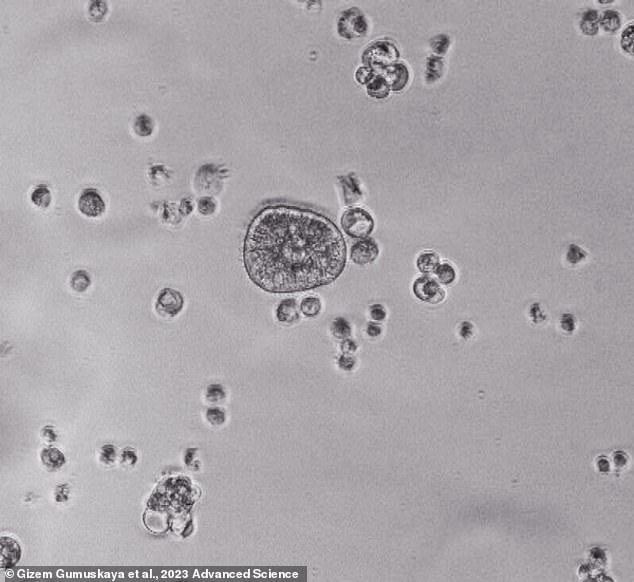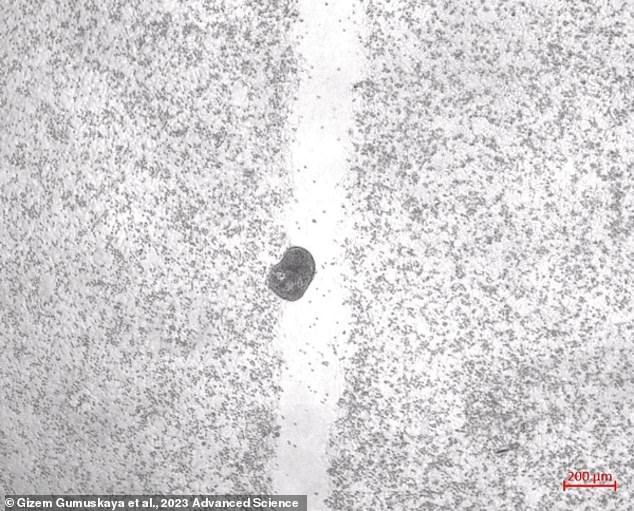Scientists unveiled breakthrough tiny robots made from HUMAN CELLS – opening the door to repairing tissue damage and treating Alzheimer’s
- These ‘anti-robots’ can be made from a person’s own cells
- In new experiments, the microscopic bots repaired damaged nerve tissue
- Scientists hope that one day they will help people with serious health problems
- READ MORE: Microscopic organisms made from frog cells collect ‘babies’ in their Pac-Man-shaped mouths
Scientists have developed tiny robots that use human cells that could one day patrol our bodies, looking for and healing diseased cells and tissue.
So-called ‘anth robots’, composed of human cells, can repair damage to brain cells in a dish, according to a study published in the magazine on Thursday Advanced science.
Scientists at Tufts University in Massachusetts developed the SIZE robots to cure diseases, but anticipate that the technology will repair cell and tissue damage caused by conditions such as Alzheimer’s disease.
These bots – whose name means ‘human robots’ – are made from human airway cells. If this technology develops to the point where it can be deployed in hospitals in the future, the fact that the bots can be made from a person’s own cells, with their own DNA, could ensure that the body does not reject them, senior author Michael Levin said to DailyMail.com.
You also wouldn’t need immunosuppressants — the kind of drugs needed after an organ transplant, said Levin, a professor of biology at Tufts. “You have the patient’s own cells doing different things in the body that are useful.”
To build the anthroporobots, scientists started with samples of the cells that line human lungs. Then they put them in a dish and allowed the cells to grow into clumps.
This ant robot is made from human lung cells, reshaped into a new form that can crawl around and repair damaged tissue
The clumps developed cilia, small hair-like projections around the outside of the cells, which help them move. Lung cells naturally grow cilia, which is a big part of why the scientists chose to use them.
Viewed in isolation, the groups of cells moved around without any help: self-driving ant robots.

The ant robots moved around on their own, propelled by the tiny hair-like projections called cilia around their exteriors.
The team then put the anthrobots to the test, in a simulation of what it might look like if they could repair human brain tissue.
In a dish containing lab-grown brain cells, the team cut a wound through the center, severing the connections between neurons.
But then they placed the ant robots in the dish and let them get to work.
Initially, the little bots walked through the center of the slash, as if they were walking down the street.

An ant robot made from human lung cells walks along a scar left in a dish of lab-grown brain cells
But once they dropped a larger group of ant robots onto the gap between the brain cells, forming a temporary connection, something amazing happened: The nerve cells began to regrow and stretch to bridge the gap.
The new work builds on previous research from the same team, which built xenobots from frog embryo cells.
In that case, embryonic cells provided a great starting place to grow the bots, but use in humans required human cells to ensure that a person’s body wouldn’t treat them as a foreign invader and attack them, creating a potentially dangerous would cause an immune response. .
But because human embryo cells cannot be used for research, they had to make do with lung cells. Fortunately, due to the explosion in human respiratory disease research since the COVID-19 pandemic, these types of cells have been in abundance.
Their next steps include testing the anthro robots in tissue that models human diseases such as dementia, to see if the bots can repair damage.
Putting them in humans is still a long way off, they said, but they are optimistic that the anthro robots will one day play a role in precision medicine.
